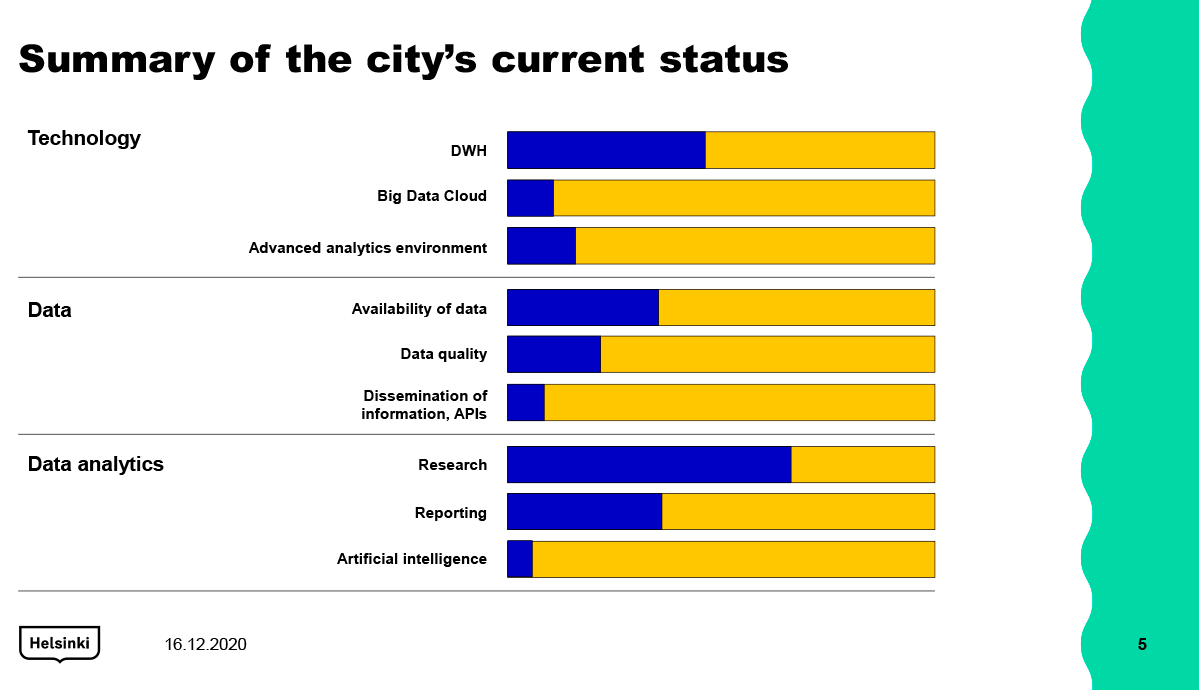1.3 The current state of data utilisation
The City of Helsinki is a large, multisectoral group, the services of which reach nearly every resident of Helsinki daily. These services produce various types of data, which is already being collected and stored in the City’s information systems and data warehouses.
The City has both strengths and weaknesses when it comes to the utilisation of data. Figure 1 presents a summary of the current state of the City’s data utilisation from the perspectives of technology, data and data analytics, each of which is explored further below.
Figure 1. Summary of the current state of the City’s data utilisation (Source: the interviews and expert analysis of the Data Strategy project)
Technology: The City’s own information resources are largely contained in its operative systems. In addition to these, the City also has a centralised data warehouse, HETA, which collects the City’s shared financial, HR and facility information and transaction information from the Social Services and Health Care Division and Education Division. However, the HETA system does not offer access to tools for big data processing, real-time data processing and machine learning methods, which are a native part of cloud solutions. Nevertheless, HETA will remain in use for the time being, and the City will carry out an assessment of how HETA can be integrated into the target architecture of the future.
The City’s Urban Research and Statistics Unit maintains a database containing statistics and research material, which is used in the utilisation and analysis of the City’s information resources. The Urban Research and Statistics Unit also administers the SAS Office Analytics software suite, which includes a wide range of data management and analysis features. Like the HETA data warehouse, the SAS software suite is optimised for the processing of structured data. Additionally, the SAS software suite is limited by its ability to only process data within its own environment, hindering the combination and sharing of data.
For data visualisation and reporting, the City uses SAS Office Analytics. Other software that has been used to some extent includes SAP BO Dashboard, Lumira and PowerBI, in addition to which the City has evaluated various other modern tools, such as Tableau and SAP Analytics Cloud. Geospatial analytics is used inconsistently in different functions.
The Data Strategy recommends monitoring the development of different technologies and analytics environments and utilising the tools that are best suited to each situation.
Data: The City has vast quantities of data, the majority of which is contained in the operative systems of City divisions. In many cases, the types of data stored in these source systems meet the quality requirements set for their original purpose, but have shortcomings in terms of interoperability, quality and consistency, among other factors, which hinders their use for other purposes. The amount of data in shared use across the City is low, and information management and sharing processes are in need of development. The development of APIs is still in its early stages, and data is rarely harmonised and distributed throughout the City.
Data analytics: The Urban Research and Statistics Unit has a long operating history and plenty of data know-how, which helps increase understanding of how important data is for the City. The unit primarily conducts one-off studies and impact assessments, although some studies are carried out periodically. In addition to this, the unit also compiles statistics, though this work does not produce analyses that are updated continuously, such as daily, for example. At present, the unit’s statistical monitoring produces monthly, quarterly and annually updated information, which is insufficient for providing the kind of real-time status information needed in many situations. Outside of the unit, the City organisation also carries out predictive analysis and scenario planning related to traffic and population development, among other things. Artificial intelligence methods have been utilised to some extent in individual pilot projects carried out by City divisions, but upscaling them to City level would require significant investments.
